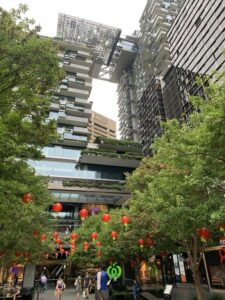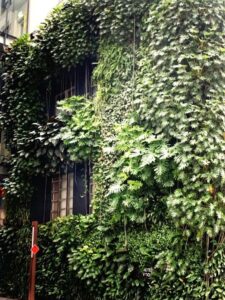
Objectives beyond aesthetics – the full potential of greening buildings
By Michael Casey
Greening buildings, a practice involving the integration of vegetation and eco-friendly features into architectural design, has gained significant traction in urban environments in recent decades. While the concept holds promise for enhancing environmental quality and reducing ecological footprints, its true impact on overall sustainability warrants careful examination. Let’s delve deeper into the true reasons we integrate plants into our buildings by examining the question “what do we need greenery to actually achieve beyond appearances?”
Around the world, planners, designers and building practitioners are experiencing first-hand the demand for nature inclusion in our built environments. The ability to integrate plants in, on and around our buildings has become a multi-faceted approach, with many professionals required at the table to ensure the success of a project. Vertical green facades and green walls have become increasingly popular in urban environments over recent decades, and their introduction into our buildings has been welcomed, but do they make developments more sustainable or are they purely a cosmetic makeover?

Sustainability experts would argue the additional materials required to build in greenery on, and in, a building may outweigh the actual benefits the plants deliver. While green infrastructure experts, on the other hand, suggest that plants seen in our built environments will help people acknowledge the current lack of nature in our built environments, and demand that more be done to help mitigate climate issues. These perspectives do raise questions about the cost-effectiveness and overall sustainability of such interventions, and where we need to strike a balance.
Finding this balance between cost-effectiveness and environmental impact is crucial in determining the true value of integrating greenery into buildings. Examples of successful projects that highlight innovative approaches maximising nature-based benefits, while minimising environmental footprint and the financial investment, are many, and are now seen as best practices for others to learn from.
One Central Park in Sydney exemplifies the successful integration of greenery into urban development. With its extensive vertical gardens and green roofs, the project not only enhances the visual appeal of the skyline but also improves air quality, reduces energy consumption, and promotes biodiversity. The constant visual of greenery is a constant reminder of why we need more nature spaces in the city.
Bosco Verticale in Milan showcases the potential of green building design to address sustainability challenges. The project’s innovative approach, featuring thousands of trees and shrubs on residential towers, demonstrates how greenery can contribute to urban greening, climate resilience, and community well-being, with occupants having a close-up connection with the plants that are cleverly integrated into their residential spaces.
Singapore on the other hand has an abundance of greenery on buildings and is not only supported by the climate, but also by regulations. This integration of vegetation in and on buildings is delivered, primarily, by two methods; applying vegetation to walls and roofs, and modulating built forms with spaces in which plants can be experienced as gardens. Even though these buildings have been carefully designed with appropriate engineering integrated into the build, the end results all lead towards the multiple benefits that come when greenery is incorporated into and onto buildings.
These benefits, which include improved air quality, increased biodiversity, enhanced wellness of people, water management and recreational appeal, are all measurable and are better identified when adding key performance indicators into the management of these assets, allowing researchers and managers to monitor sustainability successes or failures. Measuring greenery through the use of KPI’s allows us to gauge success and financial inputs, and then fully understand if the project will be successful, and more importantly, sustainable.

To ensure the long-term success of these projects, it is essential to embrace sustainable practices and possess a deep understanding of the necessary inputs. Clear definitions of maintenance needs and comprehensive education are imperative, and overseen by trained professionals in relevant fields. When planning urban green infrastructure projects, ensuring maintenance companies are present at the design table to ensure their voices are heard can come as a luxury but will provide numerous benefits for long term management and potential financial savings. Many times, projects have come undone when contracts lean towards cheaper providers who may not be able to provide the same level of service. Other examples highlight issues when the property owners or managers are truly unaware of the high costs and constant maintenance needs, especially with plant replacement, lighting and maintenance costs.
This is where education of all parties comes into action, and should start by explaining why plants grow from season to season and how the lifecycles of these living organisms can vary greatly from site to site and month to month. Too often, gardens, including green walls, are viewed by people unfamiliar with plant life cycles and are quickly deemed as possible failures or the demise of a landscape.
Education and training for asset owners and managers is also required to explain that the inputs, both financial and manual, do not stop as the asset ages. The need for property managers, committees, and the like, to understand that they are becoming lifetime gardeners or custodians of these living assets, is of utmost importance.
Professionals see a landscape as a dynamic entity that ebbs and flows as the seasons change, but others are often misguided by professionally presented artistic renders and drawings that depict a lush environment year-round. It is common practice now to view green walls as an unchanging backdrop because we find ourselves managing them this way, but we need to change the expectations about their appearance to allow people to understand that they will change as they age, and sometimes plants may die while others thrive.
Incorporating plants into buildings is not just about adding visual appeal, it is about creating healthier, more sustainable, and resilient built environments for present and future generations.
By harnessing the natural benefits of greenery, we can address pressing environmental challenges, improve human well-being, and build a more sustainable future for all.
Measuring benefits against inputs to fully understand the true sustainability of projects can sometimes be difficult, but with policies and measures in place we can better work towards understanding why we need to design plants into our bult environment, while combining it with thorough, and well-understood, education and training.
Michael Casey,
Director of Evergreen Infrastructure,
Consultant and advisor to the green infrastructure industry
Sits on the Technical Panel for the AIPH World Green Cities Awards 2024
